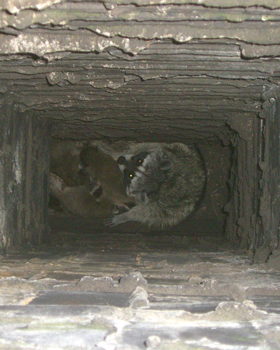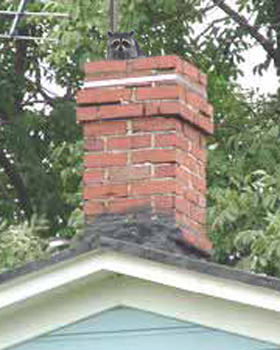WARNING: Before you start, be aware that about 85-90% of the time a raccoon is in the chimney, it's a female
raccoon with a litter of baby raccoon pups (or kits). Note the time of year. Female raccoons generally give
birth in the early spring, from late Feb to late March. The bad news - with babies, you absolutely can not remove only the adult female. The
good news - mama raccoons are very particular about having a safe den, so there's a good chance you can scare her into
moving her and her young out of the chimney on her own!
DO NOT START A FIRE: We feel that this goes without saying, but if you do this, you will be
roasting baby raccoons alive. In fact,
it's very possible that, since you have to open the damper first to let the smoke rise, that the raccoons will desperately flee out of the damper
and into your home, injured and aggressive. Absolutely do not start a fire.
CAN'T I JUST CATCH IT IN A CAGE TRAP? This is a bad idea for several reasons, but if you attempt this, and
do catch a raccoon, look at the belly. If you can see nipples, it's a lactating female with a litter of young. Moving the
female away at this point means weeks of starvation (babies are very tough) and then death for the babies in the space above
the fireplace. We do not recommend trapping.
STEP 1 - Make your presence known at the fireplace. Be loud. Bang on the top of the fireplace. Place a loud radio,
set to a talk station, in the fireplace and play it 24/76. This alone might be enough to convince her that your chimney
is not a safe place to raise her young, and she will move her and all her babies out overnight. Then you can cap the chimney
with a steel cap. Problem solved! Easy!
STEP 2 - If your noise alone was not enough to convince her to move out, then there's a special advanced
trick. Use the scent of a dominant male raccoon. Females know by instinct that a male will kill any young not its own. This
substance is called Raccoon Eviction Fluid, or paste. Soak a rag it it, and drop it down the flu, or open the damper and stick
it up there. Beware, if you open the damper, a baby or two might fall out and into the fireplace, or the female might attack your
hand. Once she smells the scent in this confined area. she will be intimidated into moving out, bringing her young with her. This has a high success rate.
STEP 3 - If that didn't work, you actually have the option of simply waiting. A raccoon can't really cause any damage in a chimney. It's a
brick and steep pipe! They will defecate, but that can be burned out after they are gone. If you wait 8-10
months after their birth, they will be grown and move out on their own. At that time, you can put a steel cap on the chimney. If you
don't want to wait that long, you can wait a mere 3 months, until they go on nightly forages, and then cap the chimney at night. Or you
can attempt to intimidate them out, as seen below.
STEP 4 - If eviction fluid did not work, and you are not willing to wait, you will now have to open the damper and remove the litter of young by hand. Usually there will be 3-5 young,
and they'll all be together, in a pile. Under 3 weeks old, and they're small with shut eyes. If they are older than 6 or 7 weeks of age, they will be fairly mobile. Wearing proper protective gear - a headlamp,
respirator mask, and gloves are a good start - pick up the litter of
baby raccoons and place them in a pillowcase. The mother may attack your arm, or she may scurry up the damper. Of course, do this at your own risk.
STEP 5 - You can place the young in a cardboard box with a blanket and hot water bottle outside, near where she crawls down. Watch the cardboard box and wait for her to go outside to it, and then go on the
roof and seal shut the flu with a proper steel cap.
CLEANUP - The raccoons will have potentially brought nesting material down the flu, and certainly left droppings and urine. You can open the damper and clean out the debris as best you can,
wearing proper safety protection. You can now start a fire to burn off some of the remnants. Odds are that you rarely use this chimney. Raccoons are far more likely to select an infrequently used chimney
that smells safe.
To find local help, click the below buttons:




